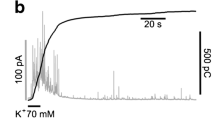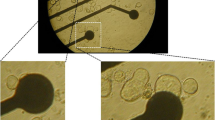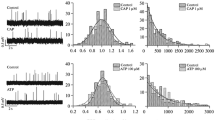Abstract
The responses in membrane potential and resistance of acinar cells to iontophoretically applied acetylcholine (ACh) were investigated using intracellular micro-electrode recording in superfused segments of mouse submaxillary gland. For measurements of membrane resistance and acetylcholine equilibrium potential (EACh), two micro-electrodes were inserted into neighbouring communicating cells. Current could be injected through one of the electrodes.
The pattern of membrane potential change induced by ACh depended on the resting potential. Simple hyperpolarizations were induced at low resting potentials, while biphasic potential changes (depolarization followed by hyperpolarization) or simple depolarizations were observed at relatively high resting potentials. A similar dependence of the ACh induced potential change on the resting potential was obtained in experiments in which the resting membrane potential was set at different levels by injecting direct current and stimulating the same cell with equal doses of ACh. The ACh equilibrium potential ranged widely between −45 and −75 mV.
Under special conditions the conversion in response to ACh from a hyperpolarization to depolarization could be obtained without change in resting potential. Small doses of ACh evoked simple depolarization, while medium doses induced biphasic responses and large doses of ACh caused hyperpolarization. The effect of a low concentration of atropine on the response was an initial block of hyperpolarization followed by a secondary block of depolarization. Intracellular injection of TEA ions converted the ACh induced potential response from hyperpolarization to depolarization. Both the depolarizing and hyperpolarizing ACh responses were accompanied by a marked reduction in membrane resistance. The depolarization was abolished by a severe reduction in external Na concentration, while the hyperpolarization was sensitive to alterations in external K concentration.
These results indicate that some of the complex responses in submaxillary gland acinar cells to ACh may be explained by the interaction between two different kinds of potential change (Na dependent depolarization and K dependent hyperpolarization).
Similar content being viewed by others
References
Hoshimiya N, Matsuo T (1974) Measurement of circuit for microelectrode bridge using operational amplifiers. Jpn J Med Electron 12:233–239
Imai Y (1965) Study of the secretion mechanism of the submaxillary gland of dog. Part 2. Effect of changing ions in the perfusate on salivary secretion and secretory, with special reference to the ionic distribution in the gland tissue. J Physiol Soc Jap 27:313–324
Kagayama M, Nishiyama A (1974) Membrane potential and input resistance in acinar cells from cat and rabbit submaxillary glands in vivo: effects of autonomic nerve stimulation. J Physiol (Lond) 242:157–172
Kleinhaus AL, Prichard JW (1974) Calcium dependent action potentials produced in leach Retzius cells by tetraethylammonium chloride. J Physiol (Lond) 246:351–361
Nishiyama A, Kagayama M (1973) Biphasic secretory potentials in cat and rabbit submaxillary glands. Experientia 29:161–163
Nishiyama A, Petersen OH (1974) Membrane potential and resistance measurement in acinar cells from salivary glands in vitro: effect of acetylcholine. J Physiol (Lond) 242:173–188
Nishiyama A, Petersen OH (1975) Pancreatic acinar cells: ionic dependence of acetylcholine-induced membrane potential and resistance change. J Physiol (Lond) 244:431–465
Nishyama A, Katoh K, Saitoh S, Wakui M (1980) Effect of neural stimulation on acinar cell membrane potentials in isolated pancreas and salivary gland segment. Membr Biochem 3:49–66
Petersen OH (1970a) Some factors influencing stimulation-induced release of potassium from the cat submandibular gland to fluid perfused through the gland. J Physiol (Lond) 208:431–447
Petersen OH (1970b) The dependence of the transmembrane salivary secretory potential on the external potassium and sodium concentration. J Physiol (Lond) 210:205–215
Petersen OH (1976) Electrophysiology of mammalian gland cells. Physiol Rev 56:535–577
Petersen OH, Ueda N (1976) Pancreatic acinar cells: the role of calcium in stimulus-secretion coupling. J Physiol (Lond) 254:583–606
Poulsen JH (1974) Acetylcholine induced transport of Na+ and K+ in the perfused cat submandibular gland. Pflügers Arch 349:215–220
Purves RD (1978) The physiology of muscarinic acetylcholine receptors. In: (Straub RW Bolis L (eds). Cell membrane receptors for drugs and hormones: A multidisciplinary approach, Raven Press, New York, pp 69–79
Roberts ML, Petersen OH (1978) Membrane potential and resistance changes induced in salivary gland acinar cells by microiontophoretic application of acetylcholine and adrenergic agonists. J Membr Biol 39:297–312
Roberts ML, Iwatsuki N, Petersen OH (1978) Parotid acinar cells: ionic dependence of acetylcholine-evoked membrane potential changes. Pflügers Arch 376:159–167
Schnever LH, Yoshida Y (1969) Secretory potentials in rat submaxillary gland. Proc Soc Exp Biol Med 130:192–196
Wakui M, Nishiyama A (1980) Ionic dependence of acetylcholine equilibrium potential of acinar cells in mouse submaxillary gland. Pflügers Arch 380:261–267
Young JA, Van Lennep EW (1978) The morphology of salivary glands, Academic Press, New York, p 46
Author information
Authors and Affiliations
Rights and permissions
About this article
Cite this article
Wakui, M., Nishiyama, A. ACh-Evoked complex membrane potential changes in mouse submaxillary gland acini. Pflugers Arch. 386, 251–259 (1980). https://doi.org/10.1007/BF00587476
Received:
Accepted:
Issue Date:
DOI: https://doi.org/10.1007/BF00587476




